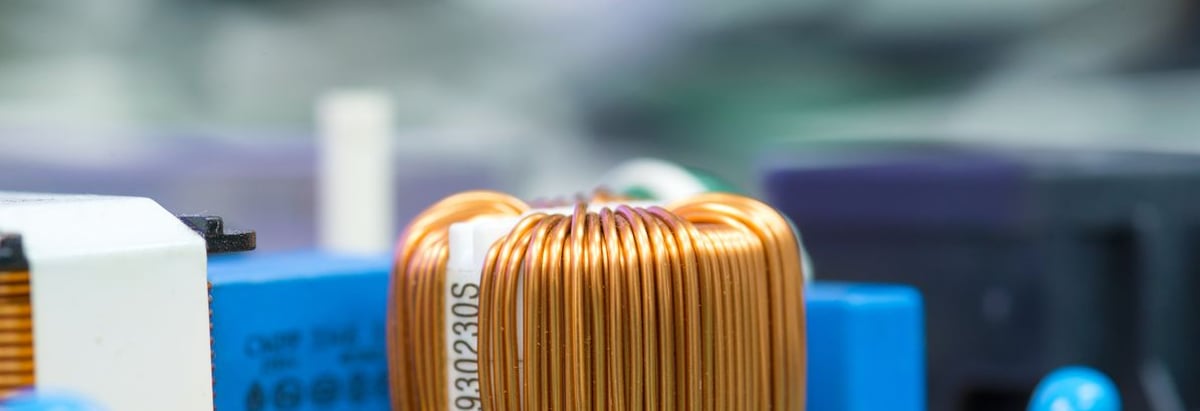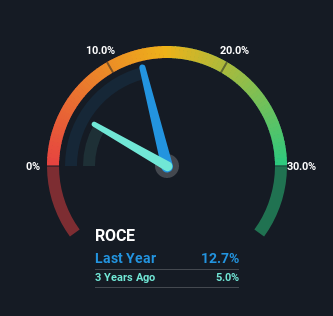- Hong Kong
- /
- Metals and Mining
- /
- SEHK:358
Jiangxi Copper (HKG:358) Might Have The Makings Of A Multi-Bagger

Did you know there are some financial metrics that can provide clues of a potential multi-bagger? Firstly, we'd want to identify a growing return on capital employed (ROCE) and then alongside that, an ever-increasing base of capital employed. Ultimately, this demonstrates that it's a business that is reinvesting profits at increasing rates of return. Speaking of which, we noticed some great changes in Jiangxi Copper's (HKG:358) returns on capital, so let's have a look.
Understanding Return On Capital Employed (ROCE)
For those who don't know, ROCE is a measure of a company's yearly pre-tax profit (its return), relative to the capital employed in the business. To calculate this metric for Jiangxi Copper, this is the formula:
Return on Capital Employed = Earnings Before Interest and Tax (EBIT) ÷ (Total Assets - Current Liabilities)
0.13 = CN¥12b ÷ (CN¥161b - CN¥67b) (Based on the trailing twelve months to December 2021).
Therefore, Jiangxi Copper has an ROCE of 13%. That's a relatively normal return on capital, and it's around the 15% generated by the Metals and Mining industry.
Check out our latest analysis for Jiangxi Copper

In the above chart we have measured Jiangxi Copper's prior ROCE against its prior performance, but the future is arguably more important. If you'd like to see what analysts are forecasting going forward, you should check out our free report for Jiangxi Copper.
How Are Returns Trending?
We like the trends that we're seeing from Jiangxi Copper. Over the last five years, returns on capital employed have risen substantially to 13%. The company is effectively making more money per dollar of capital used, and it's worth noting that the amount of capital has increased too, by 86%. This can indicate that there's plenty of opportunities to invest capital internally and at ever higher rates, a combination that's common among multi-baggers.
On a separate but related note, it's important to know that Jiangxi Copper has a current liabilities to total assets ratio of 42%, which we'd consider pretty high. This can bring about some risks because the company is basically operating with a rather large reliance on its suppliers or other sorts of short-term creditors. While it's not necessarily a bad thing, it can be beneficial if this ratio is lower.
What We Can Learn From Jiangxi Copper's ROCE
A company that is growing its returns on capital and can consistently reinvest in itself is a highly sought after trait, and that's what Jiangxi Copper has. Considering the stock has delivered 11% to its stockholders over the last five years, it may be fair to think that investors aren't fully aware of the promising trends yet. So with that in mind, we think the stock deserves further research.
One more thing to note, we've identified 2 warning signs with Jiangxi Copper and understanding them should be part of your investment process.
For those who like to invest in solid companies, check out this free list of companies with solid balance sheets and high returns on equity.
New: Manage All Your Stock Portfolios in One Place
We've created the ultimate portfolio companion for stock investors, and it's free.
• Connect an unlimited number of Portfolios and see your total in one currency
• Be alerted to new Warning Signs or Risks via email or mobile
• Track the Fair Value of your stocks
Have feedback on this article? Concerned about the content? Get in touch with us directly. Alternatively, email editorial-team (at) simplywallst.com.
This article by Simply Wall St is general in nature. We provide commentary based on historical data and analyst forecasts only using an unbiased methodology and our articles are not intended to be financial advice. It does not constitute a recommendation to buy or sell any stock, and does not take account of your objectives, or your financial situation. We aim to bring you long-term focused analysis driven by fundamental data. Note that our analysis may not factor in the latest price-sensitive company announcements or qualitative material. Simply Wall St has no position in any stocks mentioned.
About SEHK:358
Jiangxi Copper
Engages in exploring, mining, ore dressing, smelting, refining, and processing of copper in Mainland China, Hong Kong, and internationally.
Undervalued with adequate balance sheet.


